Serbia
Serbia chapter of The Banknote Book is now available
23 03, 2017 08:36 Category: The Banknote Book | Europe
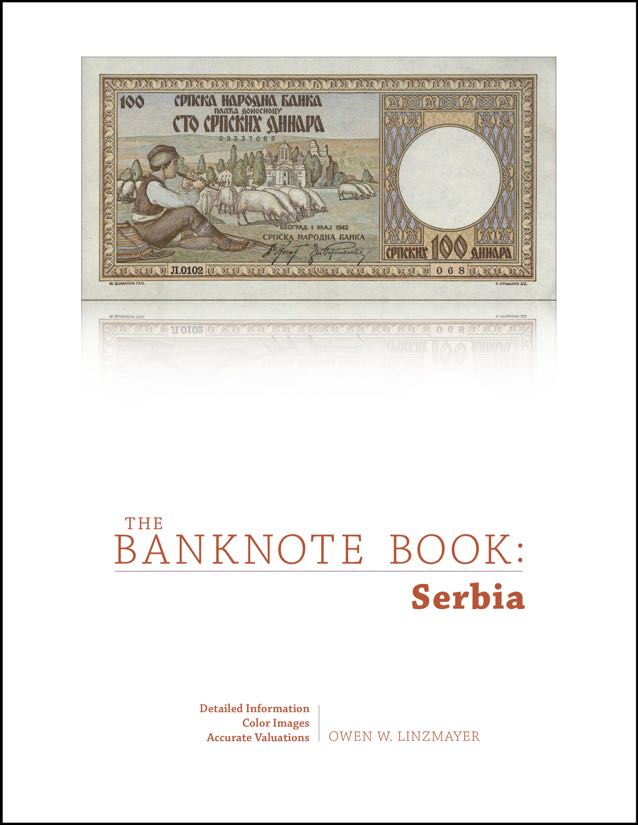
The Serbia chapter of The Banknote Book is now available for individual sale and as a free download to subscribers.
This 22-page catalog covers notes issued by Principality of Serbia in 1876, Privileged National Bank of the Kingdom of Serbia from 1884-1917, Serbian National Bank from 1941-1943, and National Bank of Serbia from 2003 to present. Revised 24 March 2017.
Each chapter of The Banknote Book includes detailed descriptions and background information, full-color images, and accurate valuations. The Banknote Book also features:
- Sharp color images of note’s front and back without overlap
- Face value or date of demonetization if no longer legal tender
- Specific identification of all vignette elements
- Security features described in full
- Printer imprint reproduced exactly as on note
- Each date/signature variety assigned an individual letter
- Variety checkboxes for tracking your collection and want list
- Date reproduced exactly as on note
- Precise date of introduction noted when known
- Replacement note information
- Signature tables, often with names and terms of service
- Background information for historical and cultural context
- Details magnified to distinguish between note varieties
- Bibliographic sources listed for further research
Subscribe to The Banknote Book
If you collect the entire world or a large number of countries, buying a subscription is the best deal because it's less expensive than buying chapters individually, and it entitles you to every chapter currently available as well as everything published—or revised (click here to see the Change Log)—during the term of your subscription.

Sign up for Email Notifications
If you would like to receive email notifications whenever a new chapter of The Banknote Book is published, please join the email list by clicking the button below.

Serbia new sig/date (2016) 5,000-dinara note (B422) confirmed
27 05, 2016 11:43 Category: Europe
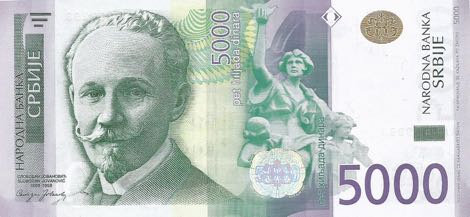
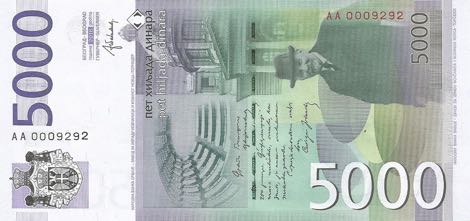
B422: Like B413, but new date (2016), new signature (Jorgovanka Tabaković), and the national coat of arms on back is more detailed, in accordance with the Decree on Establishing the Original Great and Small Coat-of-Arms, Flag and National Anthem of the Republic of Serbia, No. 85 of 15 November 2010.
Courtesy of .
Serbia new sig/date (2014) 1,000-dinar note confirmed
30 09, 2014 09:21 Category: Europe
1,000 dinara (2014), like NBS B20, but new date and new signature (Jorgovanka Tabaković).
Courtesy of Claudio Marana.
Courtesy of Claudio Marana.
Serbia new sig/date (2014) 50-dinar note confirmed
28 03, 2014 08:40 Category: Europe
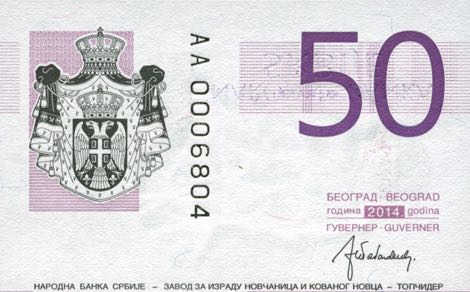
50 dinara, 2014. Like NBS B16, but new date and new signature (Jorgovanka Tabaković). Intro: 28.02.2014.
Courtesy of Thomas Augustsson.
Serbia new sig/date (2013) 200-dinar note confirmed
08 08, 2013 09:17 Category: Europe
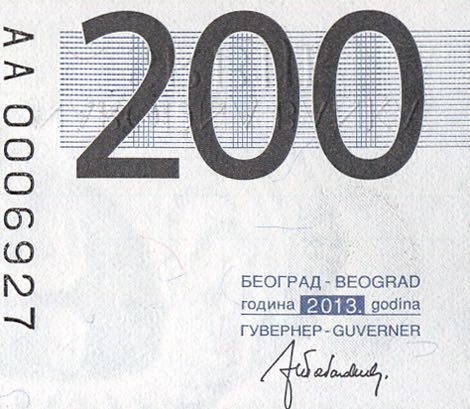
According to a press release dated 5 July 2013, the National Bank of Serbia issued a 200-dinar note like NBS B18, but with new date (2013) and signature (Jorgovanka Tabaković).
Courtesy of Thomas Augustsson and Alberto Fochi.
Book review: Coins and Banknotes of Yugoslavia, Slovenia, Croatia, Bosnia and Herzegovina, Serbia, Montenegro and Macedonia
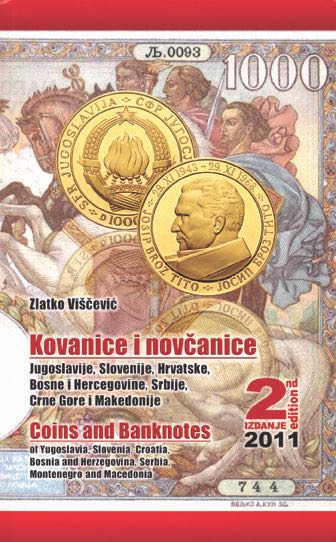
Coins and Banknotes of Yugoslavia, Slovenia, Croatia, Bosnia and Herzegovina, Serbia, Montenegro and Macedonia
Zlatko Viščević, 1173 pages, soft cover, 192 x 120 mm, black and white illustrations, Croatian and English, ISBN 978-953-56890-0-3, US$52 / €40 (free shipping), kin2.orders@gmail.com
Download the free sample chapter: Coins and Banknotes of the Kingdom of Yugoslavia.
Reviewed by Owen W. Linzmayer 7962
As author Zlatko Viščević mentions in the introduction to his impressive new catalog, collecting banknotes from the area of the former Yugoslavia can be quite challenging due to the large number of notes issued over the years. Compounding the problem is the Serbo-Croatian text on these notes and the complicated history of the region, both of which may be unfamiliar to many collectors. This new catalog doesn’t attempt to explain the tumultuous politics of the past three centuries, but is an invaluable addition to the reference library of anyone who specializes in collecting notes from this part of the world.
The first edition of this catalog was published in 2007. The second edition covers regular and commemorative notes issued in the intervening years, goes into greater depth in the descriptions, and now also includes special, fantasy, and private issues. In short, if you already own the first edition and like it, you’ll definitely want to buy the much-improved and expanded second edition.
Coins and Banknotes’ title spells out exactly what’s inside. The first half of the book is devoted to coins, the second half to notes, with chapters for the seven countries in each section. Within the chapters, the coins and notes are listed chronologically by denomination, which makes it easy to locate a particular piece and track changes over time, but at the expense of presenting complete families with common or complementary designs.
Each note type listing contains the denomination, catalog number, cross-references to Pick numbers and other specialized catalogs, reduced-size illustrations of the front and back, description of design elements and security features, and finally a list of varieties, with checkboxes for tracking your collection. Each variety is assigned a six-level rarity rating, and has values in euros for up to four levels of condition. Some notes also have auction results at the bottom of the page, though the values and results don’t always agree. Occasionally there are inset illustrations of details which determine varieties. These are useful in most cases, but sometimes the differences aren’t obvious due to the small size or lack of color in their reproduction.
Specialized collectors will appreciate the comprehensive lists of prefixes, as well as the inclusion of specimen and replacement notes in the variety tables, not to mention the assortment of “irregular issues” (color trials, partial proofs, etc.) and private/fantasy notes covered separately. While there isn’t much explanatory text regarding these issues, anyone interested in pursuing further research can consult the bibliography of source books and web sites at the end of each chapter.
The longer passages of prose in the catalog are presented in both Croatian and English, but the descriptions of the notes and their varieties are in Croatian only, which is a little frustrating if you care about such details and don’t want to rely upon Google Translate. Fortunately the English text everywhere else in the book is good enough that it’s easy to overlook the minor typos and understand the gist of the intended meaning.
One complaint I have about the catalog is its size. This is a bulky, compact tome measuring a whopping 55 millimeters thick, and heavy enough to break a toe if dropped on a foot. I would have preferred the coin and banknote sections split into two separate volumes, both printed in a larger format. As it is, the small black and white illustrations don’t do justice to the beauty of the notes, and the tiny text is hard to read if your eyesight isn’t perfect.
With this second edition, Zlatko Viščević has created a solid reference for collectors of notes of Yugoslavia and its constituent republics from 1849 to 2011. Coins and Banknotes delivers a dense helping of numismatic information at price that can’t be beat.
Serbia chapter of The Banknote Book is now available
28 06, 2013 08:10 Category: The Banknote Book | Europe

The Serbia chapter of The Banknote Book is now available for individual sale and as a free download to subscribers.
This 8-page catalog covers notes issued by Народна банка Србије/Narodna Banka Srbija (National Bank of Serbia) from 2003 to present. Revised 24 May 2016.
Each chapter of The Banknote Book includes detailed descriptions and background information, full-color images, and accurate valuations. The Banknote Book also features:
- Sharp color images of note’s front and back without overlap
- Face value or date of demonetization if no longer legal tender
- Specific identification of all vignette elements
- Security features described in full
- Printer imprint reproduced exactly as on note
- Each date/signature variety assigned an individual letter
- Variety checkboxes for tracking your collection and want list
- Date reproduced exactly as on note
- Precise date of introduction noted when known
- Replacement note information
- Signature tables, often with names and terms of service
- Background information for historical and cultural context
- Details magnified to distinguish between note varieties
- Bibliographic sources listed for further research
Subscribe to The Banknote Book
If you collect the entire world or a large number of countries, buying a subscription is the best deal because it's less expensive than buying chapters individually, and it entitles you to every chapter currently available as well as everything published—or revised (click here to see the Change Log)—during the term of your subscription.

Sign up for Email Notifications
If you would like to receive email notifications whenever a new chapter of The Banknote Book is published, please join the email list by clicking the button below.

Serbia new sig/date (2013) 10-, 20-, and 100-dinar notes confirmed
19 06, 2013 13:26 Category: Europe

On 24 May 2013, the National Bank of Serbia issued 10-, 20-, and 100-dinar notes like the preceding issues, but with new date (2013) and signature (Jorgovanka Tabaković) on back.
Courtesy of Claudio Marana and Alberto Fochi.
Serbia new sig/date (2013) 10-, 20-, and 100-dinar notes reported
05 06, 2013 08:02 Category: Europe
According to a press release, on 24 May 2013 the National Bank of Serbia issued 10-, 20-, and 100-dinar notes dated 2013 with the governor's signature as Jorgovanka Tabaković.
Courtesy of Dragan Peric.
Courtesy of Dragan Peric.
Serbia new sig/date (2012) 500- and 2,000-dinar notes confirmed
13 01, 2013 18:11 Category: Europe

According to an official press release, on 7 December 2012, the National Bank of Serbia released revised 500- (US$5.70) and 2,000-dinar (US$23) banknotes.
"The obverse of the two banknotes has not been revised, while the reverse shows a new issue year (2012) and the signature of the current governor (Jorgovanka Tabaković). The 500-dinar banknote will circulate in parallel with the earlier series of this banknote issued in 2004, 2007 and 2011, while the 2000-dinar banknote will be in parallel circulation with its 2011 issue.
"The release of revised 500- and 2000-dinar banknotes was scheduled by the annual programme of manufacturing banknotes and coins. In accordance with this programme, planned quantities of 10-, 20, 50- and 100-dinar banknotes were already printed this year. In addition, the programme for 2012 envisages printing of 500- and 2000-dinar banknotes in order to replace the worn-out, damaged and mutilated banknotes, and to ensure an optimal denomination structure of circulating banknotes.
"Further, a need was recognised to change the existing denomination structure, particularly in terms of replacing the 1000-dinar banknote which is dominant in the structure of circulating cash – around 70% in the nominal amount and around 33% in the quantity of circulating banknotes. This change would contribute to a reduction in the total number of circulating banknotes, while maintaining the same nominal quantity. Besides, this would help reduce the costs of manufacturing banknotes and cash manipulation (counting, processing, transportation, vault storage etc)."
Courtesy of Claudio Marana, Dragan Peric, and Kevin Klauss.
Serbia new 100-dinar banknote confirmed
23 07, 2012 07:11 Category: Europe

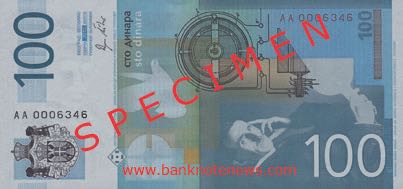
According to a press release dated 11 May 2012, the National Bank of Serbia has issued a new 100-dinar (US$1.15) banknote which is like NBS B9 (P49), "but the back contains the Great Coat-of-Arms of the Republic of Serbia in a new design, in accordance with the Decree on Establishing the Original Great and Small Coat-of-Arms, Flag and National Anthem of the Republic of Serbia (RS Official Gazette, No. 85 of 15 November 2010). The year of issue (’2012’) and the Governor’s signature have also been changed."
With this release, only the 5,000-dinar (US$57) note has yet to be issued with the new coat of arms.
Courtesy of Sejin Ahn, Dragan Peric, and Matej Omahen.
Book Review: Coins and Banknotes of Yugoslavia, Slovenia, Croatia, Bosnia and Herzegovina, Serbia, Montenegro and Macedonia

Coins and Banknotes of Yugoslavia, Slovenia, Croatia, Bosnia and Herzegovina, Serbia, Montenegro and Macedonia
Zlatko Viščević, 1173 pages, soft cover, 192 x 120 mm, black and white illustrations, Croatian and English, ISBN 978-953-56890-0-3, US$52 / €40 plus shipping, www.hrvatskanumizmatika.net
Download the free sample chapter: Coins and Banknotes of the Kingdom of Yugoslavia.
Reviewed by Owen W. Linzmayer 7962
As author Zlatko Viščević mentions in the introduction to his impressive new catalog, collecting banknotes from the area of the former Yugoslavia can be quite challenging due to the large number of notes issued over the years. Compounding the problem is the Serbo-Croatian text on these notes and the complicated history of the region, both of which may be unfamiliar to many collectors. This new catalog doesn’t attempt to explain the tumultuous politics of the past three centuries, but is an invaluable addition to the reference library of anyone who specializes in collecting notes from this part of the world.
The first edition of this catalog was published in 2007. The second edition covers regular and commemorative notes issued in the intervening years, goes into greater depth in the descriptions, and now also includes special, fantasy, and private issues. In short, if you already own the first edition and like it, you’ll definitely want to buy the much-improved and expanded second edition.
Coins and Banknotes’ title spells out exactly what’s inside. The first half of the book is devoted to coins, the second half to notes, with chapters for the seven countries in each section. Within the chapters, the coins and notes are listed chronologically by denomination, which makes it easy to locate a particular piece and track changes over time, but at the expense of presenting complete families with common or complementary designs.
Each note type listing contains the denomination, catalog number, cross-references to Pick numbers and other specialized catalogs, reduced-size illustrations of the front and back, description of design elements and security features, and finally a list of varieties, with checkboxes for tracking your collection. Each variety is assigned a six-level rarity rating, and has values in euros for up to four levels of condition. Some notes also have auction results at the bottom of the page, though the values and results don’t always agree. Occasionally there are inset illustrations of details which determine varieties. These are useful in most cases, but sometimes the differences aren’t obvious due to the small size or lack of color in their reproduction.
Specialized collectors will appreciate the comprehensive lists of prefixes, as well as the inclusion of specimen and replacement notes in the variety tables, not to mention the assortment of “irregular issues” (color trials, partial proofs, etc.) and private/fantasy notes covered separately. While there isn’t much explanatory text regarding these issues, anyone interested in pursuing further research can consult the bibliography of source books and web sites at the end of each chapter.
The longer passages of prose in the catalog are presented in both Croatian and English, but the descriptions of the notes and their varieties are in Croatian only, which is a little frustrating if you care about such details and don’t want to rely upon Google Translate. Fortunately the English text everywhere else in the book is good enough that it’s easy to overlook the minor typos and understand the gist of the intended meaning.
One complaint I have about the catalog is its size. This is a bulky, compact tome measuring a whopping 55 millimeters thick, and heavy enough to break a toe if dropped on a foot. I would have preferred the coin and banknote sections split into two separate volumes, both printed in a larger format. As it is, the small black and white illustrations don’t do justice to the beauty of the notes, and the tiny text is hard to read if your eyesight isn’t perfect.
With this second edition, Zlatko Viščević has created a solid reference for collectors of notes of Yugoslavia and its constituent republics from 1849 to 2011. Coins and Banknotes delivers a dense helping of numismatic information at price that can’t be beat.
Serbia new 500- and 1,000-dinar notes confirmed
12 01, 2012 15:32 Category: Europe


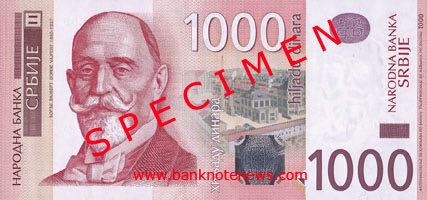
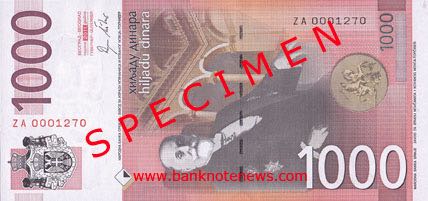
According to a press release, on 30 December 2011, the National Bank of Serbia issued modified 500- and 1,000-dinar (US$6 and $12, respectively) notes which feature a new design of the coat of arms on the back, in accordance with the Decree on Establishing the Original Great and Small Coat-of-Arms, Flag and National Anthem of the Republic of Serbia (RS Official Gazette, No 85 of 15 November 2010). The date on these notes is 2011. Both notes will circulate in parallel with preceding issues of the same denominations.
Courtesy of David Murcek (www.themonetaryunit.com), Claudio Marana, and Matej Omahen.
Serbia new 2,000-dinar note confirmed
12 01, 2012 15:33 Category: Europe
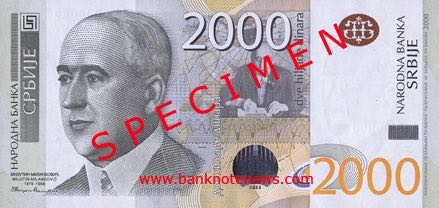
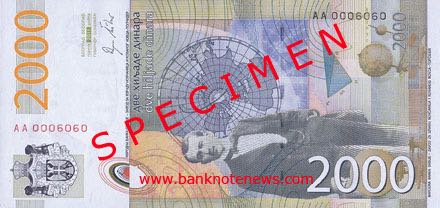
According to a press release dated 23.12.2011, the National Bank of Serbia issued a new 2,000-dinar (US$25.27) banknote on 30 December 2011. This note is intended to ease economic transactions by filling the gap between the 1,000 and 5,000 dinar denominations. The new note features a portrait of scientist Milutin Milanković on front and fragments of his scientific works on back.
Governor Dejan Soskic claimed, “New banknotes from 2,000 dinars will reduce the total amount of banknotes in circulation for about 20 million pieces, and therefore the cost of production for about 170 million dinars, will facilitate the operations of money and will complete the current series of banknotes issued by the National Bank of Serbia.” The new banknotes have machine-readable security elements, OVD, holograms, and embedded fibers that make the new Serbian banknote extremely difficult to counterfeit.
Courtesy of David Murcek (www.themonetaryunit.com), Matej Omahen, Andrija MIlosevic, Mojmir Cerny, and Radio-televizija Srbije.
Serbia new 10-, 20-, and 200-dinar notes confirmed
26 10, 2011 09:03 Category: Europe
On 30 September 2011, the National Bank of Serbia issued new notes dated 2011, denominated in 10, 20, and 200 dinars, all bearing the new Serbian coat of arms on back and a new signature (Dejan Šoškić, Governor).
Notes denominated in 100, 500, 1,000, and 5,000 dinars have not been similarly updated, but will probably be revised when stocks of these notes are exhausted.
Courtesy of Matej Omahen, Dragan, and Thomas Augustsson.
Notes denominated in 100, 500, 1,000, and 5,000 dinars have not been similarly updated, but will probably be revised when stocks of these notes are exhausted.
Courtesy of Matej Omahen, Dragan, and Thomas Augustsson.
Serbia new 50-dinar note confirmed
22 08, 2011 08:29 Category: Europe
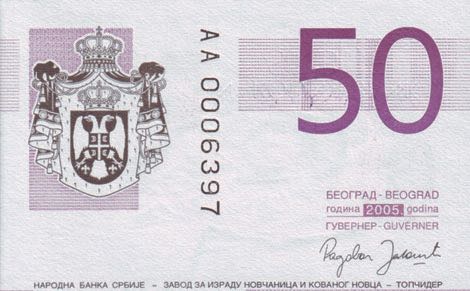
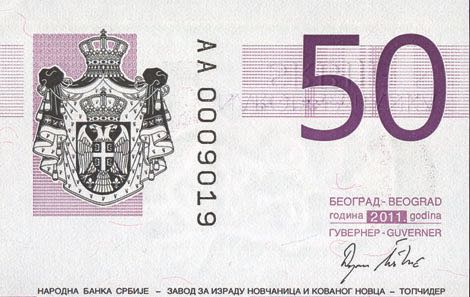
50 dinars (US$0.70), 2011. Like P40 (top), but new date, new signature (Dejan Šoškić, Governor), and modified coat of arms (more detailed illustration).
Courtesy of Alberto Fochi.
Serbia new 5,000-dinar note confirmed
05 12, 2010 11:17 Category: Europe
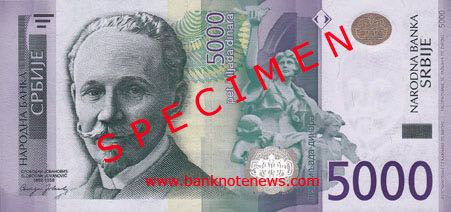

According to a press release, on 26 November 2010 the National Bank of Serbia issued a new 5,000-dinar (US$61.10) banknote that will circulate in parallel with the same denomination note issued in 2003 (P45). The new note retains the overall design of the old note with the following changes:
on the front of the banknote
1. the position and the form of the kip effect and OVI elements are changed;
on the back of the banknote
1. the year of issue (2010) and governor’s signature are changed;
2. the logo of the National Bank of Serbia is replaced with the Great Coat-of-Arms of the Republic of Serbia;
3. the year of issue and governor’s signature are no longer below the logo of the National Bank of Serbia, but in the right part of the white area;
4. lettering (handwriting of S. Jovanović) in intaglio print is added in the central part of the banknote;
5. the serial number is placed between the Great Coat-of-Arms of the Republic of Serbia and the value numeral, instead to the right of the value numeral;
6. Cyrillic lettering “Narodna banka Srbije – Zavod za izradu novčanica i kovanog novca Topčider“ (National Bank of Serbia – Institute for Manufacturing Banknotes and Coins Topčider) is now placed above the upper edge of the fully printed area instead of directly above its lower edge.
Courtesy of Matej Omahen.
Serbia to issue a new series of notes in 2010
30 12, 2007 08:50 Category: Europe
In December 2007, the National Bank of Serbia announced a design competition open to the public to create a new banknote series containing nine denominations: 10, 20, 50, 100, 200, 500, 1,000, 2,000, and 5,000 dinars. The new notes aren’t expected to be issued until 2010.
Serbia issues new 10-dinar note dated 2006
19 05, 2006 11:09 Category: Europe
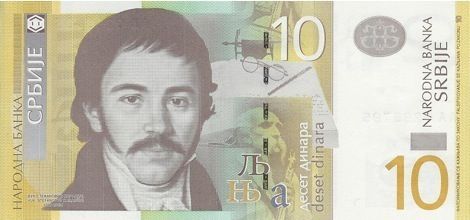

10 dinar, 2006. Issued May 19, 2006. Ochre-yellow, brown, and green. Signature: Radovan Jelasic, guverner. Vuk Stefanovic Karadic, the creator of contemporary Serbian alphabet, his writing kit, and an open book (exhibits from the standing collection of the Museum devoted to Vuk S. Karadic and Dositej Obradovic). Members of the First Slavic Congress held in Prague in 1848 and vignette of the letters Karadic introduced on back (vertical format). 131 x 62 mm.
Caaourtesy of Chris Twining.
Serbia issues new 20-dinar note dated 2006
18 07, 2006 11:08 Category: Europe

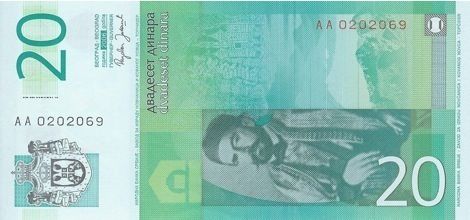
20 dinar, 2006. Issued July 18, 2006. Green, ochre-yellow, and black. Signature: Radovan Jelasic, guverner. Petar II Petrovi Njego, with a line sketch of the Cetinje monastery at right. Figure of Petar II Petrovi Njego, detail from the decorative miniature featured on the first Slavic Octoechos, printed in Cetinje in 1494, mountain range of Komovi on back (vertical format). 135 x 64 mm.
Courtesy of Chris Twining.
Serbia issues revised 1,000-dinar note dated 2006
18 07, 2006 11:08 Category: Europe

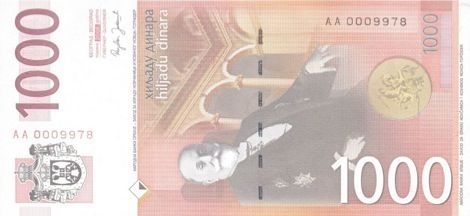
1,000 dinar, 2006. Issued July 18, 2006. Like Pick 44, but with new Serbian coat of arms below serial number on back (vertical format), and new signature: Radovan Jelasic, guverner. 151 x 72 mm.
Courtesy of Igor Dolasevic.
Serbia issues new 100-dinar note dated 2006
20 10, 2006 10:33 Category: Europe

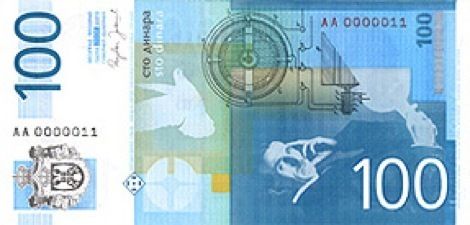
100 dinar, 2006. Issued October 20, 2006. Like Pick 41, but with new coat of arms and signature (Radovan Jelasic, guverner) on back. Blue, green, and ochre-yellow. Scientist Nikola Tesla, magnetic induction calculation formula, electrical discharge, and Tesla’s electric induction device. Tesla (from the photograph of Nikola Tesla from his Museum in Belgrade), electromagnetic engine, and “Tesla’s Dove” on back. 143 x 68 mm.
Courtesy of National Bank of Serbia.
Serbia issues new date (2007) 500-dinar note
04 06, 2007 16:34 Category: Europe

500 dinars (US$8.30), 2007. Issued June 4, 2007. Like Pick 43a, but new date and Republic of Serbia coat of arms instead of National Bank of Serbia logo.
Courtesy of Igor Dolasevic.
Serbia issues revised 100-dinara note dated 2006
30 09, 2007 12:14 Category: Europe
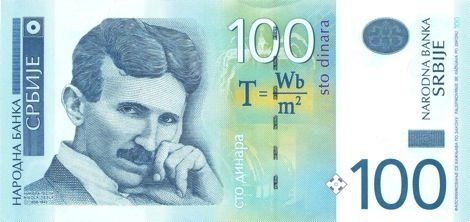

100 dinara (US$1.70), 2006. Like SCWPM 41, but new date, repositioned registration device, and Republic of Serbia coat of arms instead of National Bank of Serbia logo on back.
Courtesy of banknoteshop@gmx.net.

